【语法考点夯实】2015年聚焦中考英语(甘肃)语法课件:第31讲 疑问句和倒装句(共23张PPT)
文档属性
| 名称 | 【语法考点夯实】2015年聚焦中考英语(甘肃)语法课件:第31讲 疑问句和倒装句(共23张PPT) | 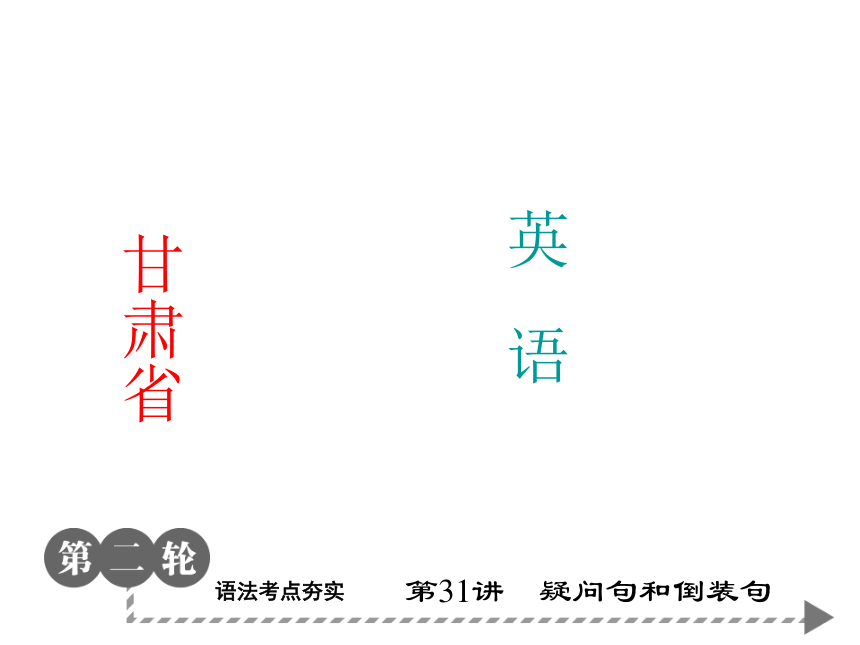 | |
| 格式 | zip | ||
| 文件大小 | 294.3KB | ||
| 资源类型 | 教案 | ||
| 版本资源 | 通用版 | ||
| 科目 | 英语 | ||
| 更新时间 | 2014-12-21 07:29:33 | ||
图片预览

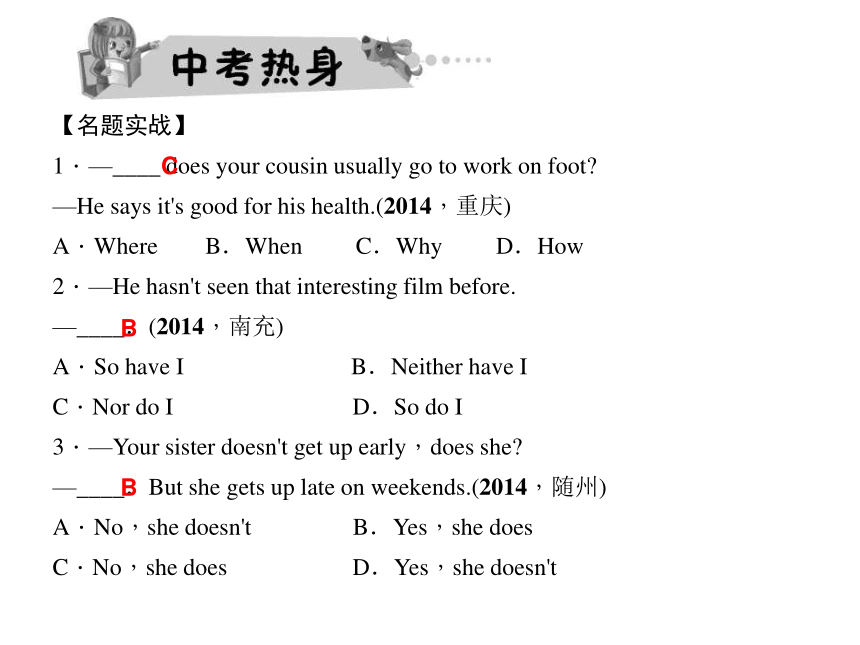
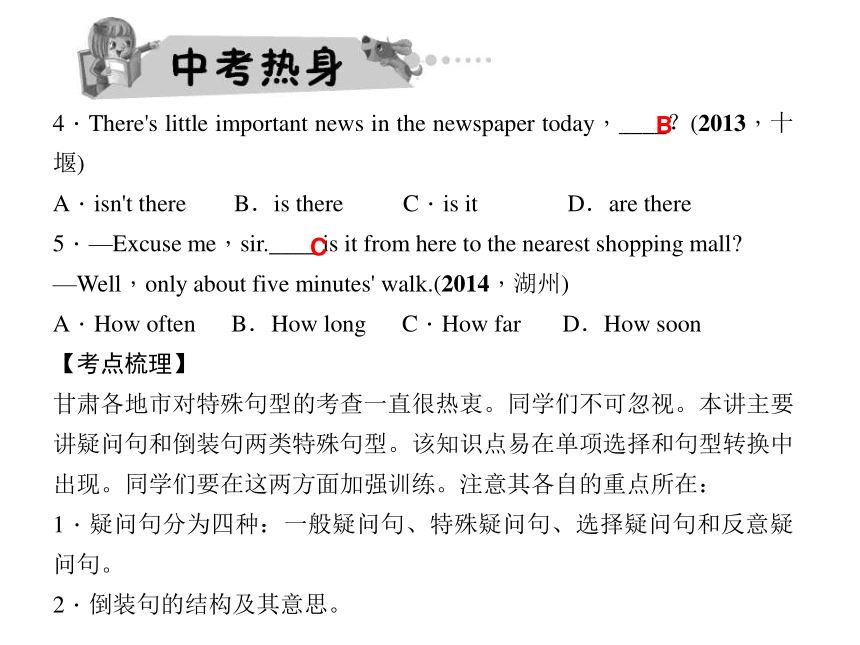
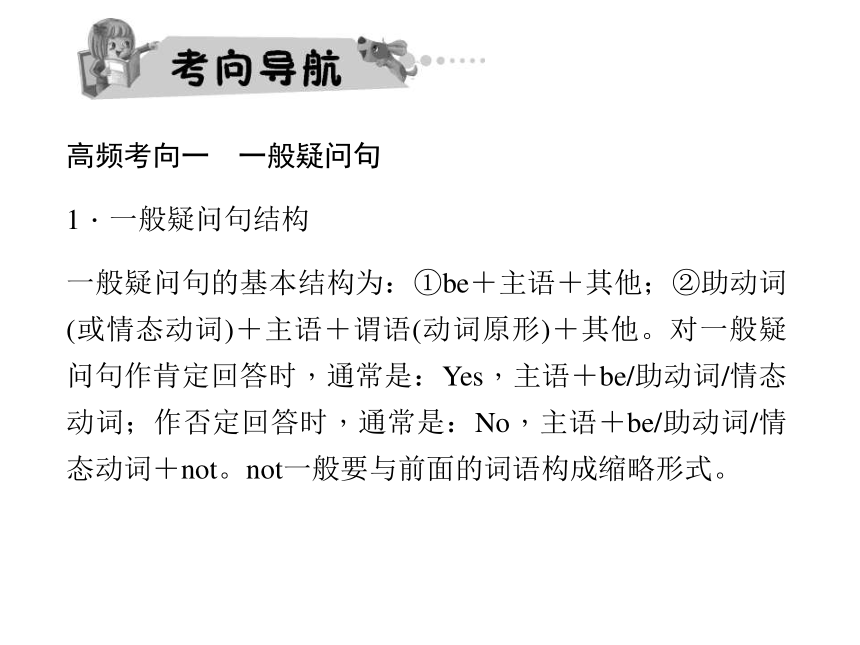
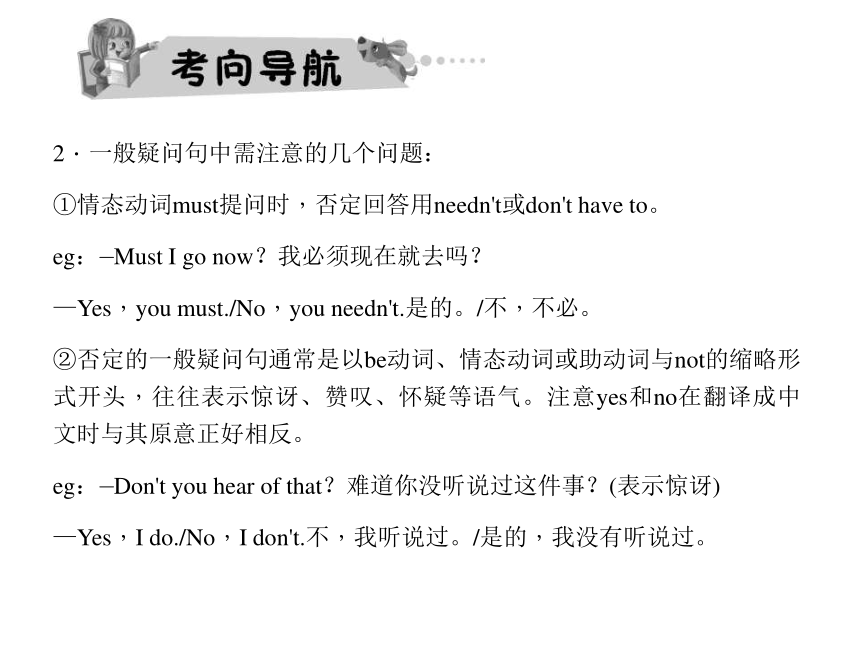
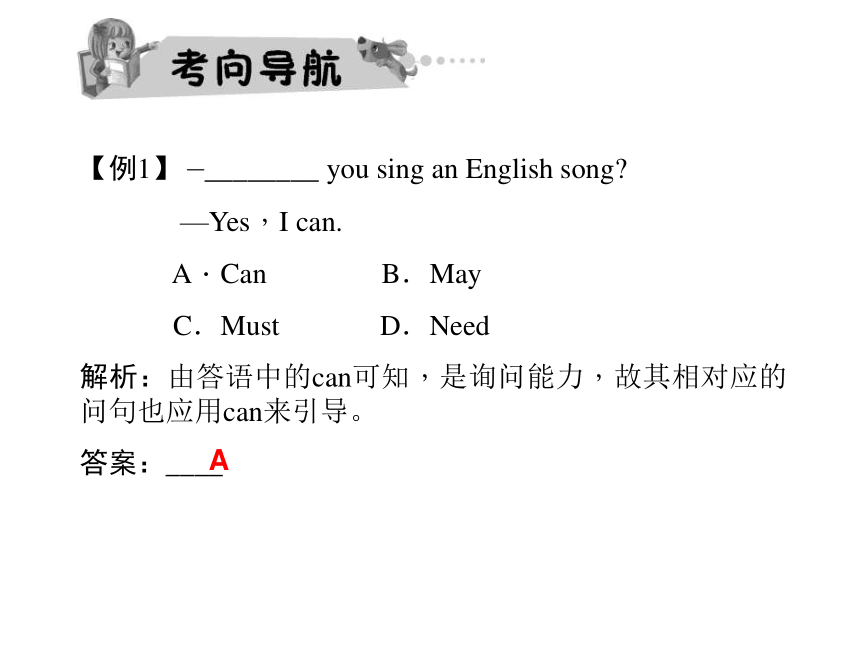
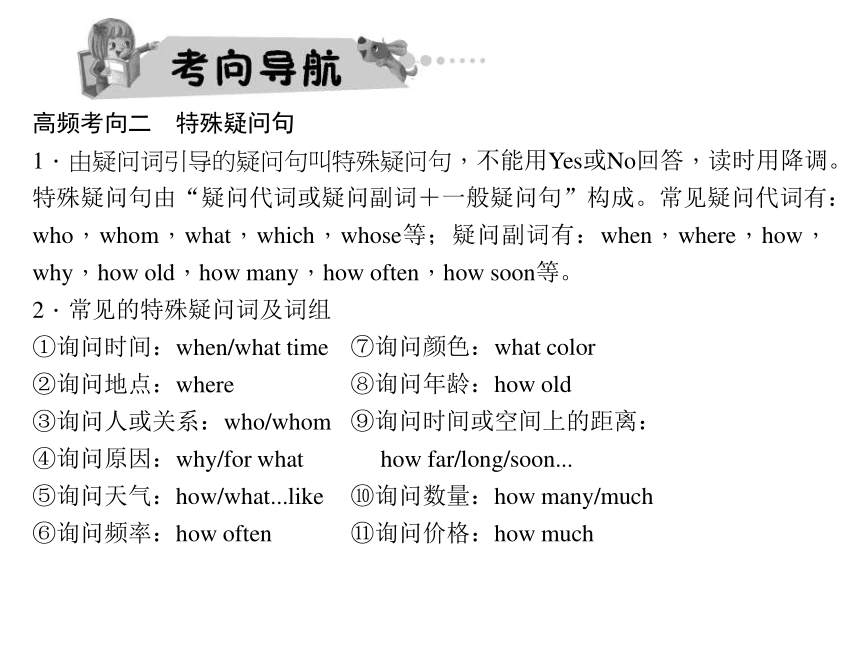


文档简介
课件23张PPT。甘肃省英
语语法考点夯实 第31讲 疑问句和倒装句 【名题实战】
1.—____ does your cousin usually go to work on foot?
—He says it's good for his health.(2014,重庆)
A.Where B.When C.Why D.How
2.—He hasn't seen that interesting film before.
—____.(2014,南充)
A.So have I B.Neither have I
C.Nor do I D.So do I
3.—Your sister doesn't get up early,does she?
—____.But she gets up late on weekends.(2014,随州)
A.No,she doesn't B.Yes,she does
C.No,she does D.Yes,she doesn'tCBB4.There's little important news in the newspaper today,____?(2013,十堰)
A.isn't there B.is there C.is it D.are there
5.—Excuse me,sir.____ is it from here to the nearest shopping mall?
—Well,only about five minutes' walk.(2014,湖州)
A.How often B.How long C.How far D.How soon
【考点梳理】
甘肃各地市对特殊句型的考查一直很热衷。同学们不可忽视。本讲主要讲疑问句和倒装句两类特殊句型。该知识点易在单项选择和句型转换中出现。同学们要在这两方面加强训练。注意其各自的重点所在:
1.疑问句分为四种:一般疑问句、特殊疑问句、选择疑问句和反意疑问句。
2.倒装句的结构及其意思。BC高频考向一 一般疑问句
1.一般疑问句结构
一般疑问句的基本结构为:①be+主语+其他;②助动词(或情态动词)+主语+谓语(动词原形)+其他。对一般疑问句作肯定回答时,通常是:Yes,主语+be/助动词/情态动词;作否定回答时,通常是:No,主语+be/助动词/情态动词+not。not一般要与前面的词语构成缩略形式。 2.一般疑问句中需注意的几个问题:
①情态动词must提问时,否定回答用needn't或don't have to。
eg:—Must I go now?我必须现在就去吗?
—Yes,you must./No,you needn't.是的。/不,不必。
②否定的一般疑问句通常是以be动词、情态动词或助动词与not的缩略形式开头,往往表示惊讶、赞叹、怀疑等语气。注意yes和no在翻译成中文时与其原意正好相反。
eg:—Don't you hear of that?难道你没听说过这件事?(表示惊讶)
—Yes,I do./No,I don't.不,我听说过。/是的,我没有听说过。【例1】 —________ you sing an English song?
—Yes,I can.
A.Can B.May
C.Must D.Need
解析:由答语中的can可知,是询问能力,故其相对应的问句也应用can来引导。
答案:____A高频考向二 特殊疑问句
1.由疑问词引导的疑问句叫特殊疑问句,不能用Yes或No回答,读时用降调。特殊疑问句由“疑问代词或疑问副词+一般疑问句”构成。常见疑问代词有:who,whom,what,which,whose等;疑问副词有:when,where,how,why,how old,how many,how often,how soon等。
2.常见的特殊疑问词及词组
①询问时间:when/what time
②询问地点:where
③询问人或关系:who/whom
④询问原因:why/for what
⑤询问天气:how/what...like
⑥询问频率:how often⑦询问颜色:what color
⑧询问年龄:how old
⑨询问时间或空间上的距离:
how far/long/soon...
⑩询问数量:how many/much
?询问价格:how much【例2】—________ do you go shopping?
—Sometimes.(2014,梅州)
A.How often B.How long C.How far D.How much
解析:由答语“有时”可知询问频率。
答案:____
【例3】 —________ have you been in the sports club?
—Since the first month I came to the school.(2013,上海)
A.How old B.How long C.How much D.How soon
解析:考查疑问副词的用法。how old 表示“多大”,用来提问年龄;how long 表示“(延续)多长时间”,用for或since引导的时间状语来回答;how often 表示“多久一次”,指动作的频率;how soon表示“还要多久才……”,一般用于将来时,用“in”引导的时间状语来回答。由答语可知,提问的是一段时间。
答案:____AB高频考向三 选择疑问句
提出两种或两种以上的情况,要求对方作出选择回答的问句叫选择疑问句。选择疑问句中两种或两种以上的情况用or连接,回答时不能用yes或no,要用一个完整的句子或其省略形式。语调一般是前升后降。选择疑问句可以分为一般选择疑问句和特殊疑问句两种。
①一般选择疑问句:一般疑问句+or+被选择的部分?
eg:—Do you like apples or pears?你喜欢苹果还是梨?
—I like pears.我喜欢梨。
②特殊选择疑问句:特殊疑问句+A or B?
eg:—Which would you like better,tea or coffee?茶或咖啡,你更喜欢哪一种?
—I'd like coffee.我喜欢咖啡。【例4】 —Is your friend a boy or a girl?
— ________.
A.No,she isn't B.A girl
C.The girl D.Yes,she is
解析:选择疑问句不能用Yes或No回答,排除A、D项;根据问句,回答用a girl。
答案:____B高频考向四 反意疑问句
1.反意疑问句是附在陈述句之后,对陈述句所说的事实或观点提出疑问的句子。反意疑问句由两部分组成,前一部分为陈述句,后一部分为简短的一般疑问句。若前部分为肯定句,后一部分就要用否定形式,而且必须用缩略形式;若前一部分用否定形式,后一部分就用肯定形式。即:“前肯后否,前否后肯”。两部分的人称和时态要一致。
2.几种特殊的反意疑问句
?当陈述部分含有否定意义的词如 hardly,few,little,no,nobody,no one,nothing等时,附加疑问部分须用肯定形式。但若陈述部分含有带否定前缀如im-,un-,dis-等的派生词,仍作为肯定结构,附加疑问句部分用否定式。
?I am...反意疑问句附加疑问句部分应为aren't I。?如果陈述部分是肯定或否定的祈使句,疑问部分须用 will you。
?当陈述部分是let's do sth.时,疑问部分须用shall we来反问;而当陈述部分是let sb.do sth.时,疑问部分用will you 来反问。
?陈述部分的谓语是used to 时,附加疑问句部分用“didn't+主语”或“usedn't+主语”。如:
He used to go to bed late,didn't he/usedn't he?他过去睡觉很晚,对吗?
?need 的反意疑问句
①实义动词时,用“助动词+(not)+主语”。如:
We need to come earlier,don't we?我们需要来早点,对吗?
②情态动词时,用“need+(not)+主语”。如:
We need't come so early,need we?我们不必来那么早,对吗??当陈述部分主语是不定代词 nobody,somebody,no one时,疑问句部分须用复数代词they,也可以用he;当陈述部分主语是不定代词 nothing,something时,疑问部分须用代词it。
?若陈述部分为there be 句型,附加疑问部分仍用be (not) there。
?主从复合句的反意疑问句附加疑问句部分的助动词与人称应与主句的谓语动词和人称保持一致。若宾语从句的主语为“I think/suppose/believe”等表示说话人的看法,反意疑问句的疑问部分应与宾语从句的主谓保持一致。
3.反意疑问句的回答,无论问题的提法如何,如果事实是肯定的,就用yes;事实是否定的,就要用no。要特别注意在“前否后肯”的句型中,回答yes要译成“不”,no要译成“是”。如:
—He likes playing football,doesn't he?他喜欢踢足球,是吗?
—Yes,he does./No,he doesn't.是的。/ 不是。
—His sister didn't attend the meeting,did she?他妹妹没有参加会议,是吗?
—Yes,she did./No,she didn't.不,她参加了。/是的,她没参加。【例5】 There is little water in the bottle,________?
A.is it B.isn't it C.is there D.isn't there
解析:本题考查反意疑问句的用法。句子由there be引导,反意疑问句也应由there be构成,故排除选项A和B;little意为“很少,几乎没有”,表示否定意义,故反意疑问句用肯定形式。
答案:____
【例6】It's sunny today. Let's fly kites in the park,______?
解析:以let's 引导的反意疑问句应用shall we。
答案:_________Cshall we高频考向五 倒装句的用法
英语句子的自然语序是主语在前,谓语动词在后。如果把谓语动词放在之前,就构成了倒装句。下面是几种倒装句的具体形式:
1.
这两种倒装结构常用来说明前面所说的情况也同样适用于后面的人或物。“so+倒装”常用于表示肯定的相同情况;而“neither/nor+倒装”常用于表示否定的相同情况。
注意:这种结构中的助动词/be动词/情态动词在形式上与前句的谓语保持一致,而其单复数形式则由后句的主语决定。如:
Lucy is a good student,so is Lily.
露西是个好学生,莉莉也是。
Mary didn't watch TV last night,neither did Jim.
玛丽昨晚没有看电视,吉姆也没看。so+助动词/be动词/情态动词+主语
neither/nor+助动词/be动词/情态动词+主语2.there be 句型
there be 句型表示“存在”,是一个主语在be动词后面的倒装句。如:
There is a tree in front of the building.楼房前有一棵树。
3.以副词开头的倒装句
在以here,there,out,in,down,away等表示方位的副词开头的句子中,如果主语是名词,要用倒装句。因此,谓语动词的形式由位于倒装句句尾的主语决定。如:
There comes the bus.公交车来了。【例7】 —Peter doesn't know many people here.
—________.
A.So do I B.So am I C.Neither am I D.Neither do I
解析:上文是否定句,意为“彼得不认识这里的许多人”。可知下文句意应为“我也不认识。”应由neither引导,结合上文的谓语动词为doesn't know 可知此处应用do。
答案:____
【例8】 Between the two hills ________ a deep river.
A.are B.have C.has D.is
解析:本句考查倒装句,结合英语提示可知正确语序为“A deep river is between the two hills.”意为“在这两座山之间有一条河。”
答案:____DD一、单项选择。
1.—Did you use to have long hair or short hair,Sally?
—____.(2014,兰州)
A.Yes,I did B.No,I didn't C.Long hair D.Curly hair
2.—Who reached the station on time?(2014,兰州)
—I ____!In fact,I arrived there 5 minutes earlier.
A.was B.reached C.did D.do
3.—I have changed my job.
—____.(2011,兰州)
A.So do I B.So have I C.So,I do D.So I have
4.—Has your mother ever been to London?
—Yes,and ____.We went together.(2014,平凉)
A.so have I B.so I have C.neither have I D.neither I haveCCBA5.—____ is it from the village to your school?
—About 5 kilometers.(2014,黔南)
A.How often B.How soon C.How long D.How far
6.—____ people are there in your family?
—Three.(2014,北京)
A.How often B.How long
C.How many D.How much
7.—We'd better invite Jim and Jack to the party tonight.
—Yes,____?I'll give them a call right now.(2014,武汉)
A.why B.why not C.what for D.howDCB8.—____ will the fog and haze last?(2014,连云港)
—I've no idea.There is no sign of an end.
A.How soon B.How far C.How long D.How often
9.—He hasn't watched the movie “So Young”,has he?
—____.He told me it's very moving and interesting,he'd like to watch it again.(2014,兰州)
A.Yes,he has B.Yes,he hasn't
C.No,he hasn't D.No,he has
10.Do you know ____ I saw yesterday?It was my favorite star,Jackie!(2013,江西)
A.whom B.when C.where D.howCAA二、句型转换。
11.Sam didn't go to school yesterday,did he?(作肯定回答)
, .
12.Tell me the way to the cinema.(改为反意疑问句)
Tell me the way to the cinema,____ _____
13.I would like a_big_bowl of mutton soup.(对画线部分提问)
bowl of mutton soup would you like?
14.Tom visits his grandparents once_a_week.(对画线部分提问)
Tom visit his grandparents?
15.Our village has changed a lot.Hers has changed a lot,too.(改为倒装句)
Our village has changed a lot. .Yes he didwill you?What sizeHow often doesSo has hers请完成考点跟踪突破31
语语法考点夯实 第31讲 疑问句和倒装句 【名题实战】
1.—____ does your cousin usually go to work on foot?
—He says it's good for his health.(2014,重庆)
A.Where B.When C.Why D.How
2.—He hasn't seen that interesting film before.
—____.(2014,南充)
A.So have I B.Neither have I
C.Nor do I D.So do I
3.—Your sister doesn't get up early,does she?
—____.But she gets up late on weekends.(2014,随州)
A.No,she doesn't B.Yes,she does
C.No,she does D.Yes,she doesn'tCBB4.There's little important news in the newspaper today,____?(2013,十堰)
A.isn't there B.is there C.is it D.are there
5.—Excuse me,sir.____ is it from here to the nearest shopping mall?
—Well,only about five minutes' walk.(2014,湖州)
A.How often B.How long C.How far D.How soon
【考点梳理】
甘肃各地市对特殊句型的考查一直很热衷。同学们不可忽视。本讲主要讲疑问句和倒装句两类特殊句型。该知识点易在单项选择和句型转换中出现。同学们要在这两方面加强训练。注意其各自的重点所在:
1.疑问句分为四种:一般疑问句、特殊疑问句、选择疑问句和反意疑问句。
2.倒装句的结构及其意思。BC高频考向一 一般疑问句
1.一般疑问句结构
一般疑问句的基本结构为:①be+主语+其他;②助动词(或情态动词)+主语+谓语(动词原形)+其他。对一般疑问句作肯定回答时,通常是:Yes,主语+be/助动词/情态动词;作否定回答时,通常是:No,主语+be/助动词/情态动词+not。not一般要与前面的词语构成缩略形式。 2.一般疑问句中需注意的几个问题:
①情态动词must提问时,否定回答用needn't或don't have to。
eg:—Must I go now?我必须现在就去吗?
—Yes,you must./No,you needn't.是的。/不,不必。
②否定的一般疑问句通常是以be动词、情态动词或助动词与not的缩略形式开头,往往表示惊讶、赞叹、怀疑等语气。注意yes和no在翻译成中文时与其原意正好相反。
eg:—Don't you hear of that?难道你没听说过这件事?(表示惊讶)
—Yes,I do./No,I don't.不,我听说过。/是的,我没有听说过。【例1】 —________ you sing an English song?
—Yes,I can.
A.Can B.May
C.Must D.Need
解析:由答语中的can可知,是询问能力,故其相对应的问句也应用can来引导。
答案:____A高频考向二 特殊疑问句
1.由疑问词引导的疑问句叫特殊疑问句,不能用Yes或No回答,读时用降调。特殊疑问句由“疑问代词或疑问副词+一般疑问句”构成。常见疑问代词有:who,whom,what,which,whose等;疑问副词有:when,where,how,why,how old,how many,how often,how soon等。
2.常见的特殊疑问词及词组
①询问时间:when/what time
②询问地点:where
③询问人或关系:who/whom
④询问原因:why/for what
⑤询问天气:how/what...like
⑥询问频率:how often⑦询问颜色:what color
⑧询问年龄:how old
⑨询问时间或空间上的距离:
how far/long/soon...
⑩询问数量:how many/much
?询问价格:how much【例2】—________ do you go shopping?
—Sometimes.(2014,梅州)
A.How often B.How long C.How far D.How much
解析:由答语“有时”可知询问频率。
答案:____
【例3】 —________ have you been in the sports club?
—Since the first month I came to the school.(2013,上海)
A.How old B.How long C.How much D.How soon
解析:考查疑问副词的用法。how old 表示“多大”,用来提问年龄;how long 表示“(延续)多长时间”,用for或since引导的时间状语来回答;how often 表示“多久一次”,指动作的频率;how soon表示“还要多久才……”,一般用于将来时,用“in”引导的时间状语来回答。由答语可知,提问的是一段时间。
答案:____AB高频考向三 选择疑问句
提出两种或两种以上的情况,要求对方作出选择回答的问句叫选择疑问句。选择疑问句中两种或两种以上的情况用or连接,回答时不能用yes或no,要用一个完整的句子或其省略形式。语调一般是前升后降。选择疑问句可以分为一般选择疑问句和特殊疑问句两种。
①一般选择疑问句:一般疑问句+or+被选择的部分?
eg:—Do you like apples or pears?你喜欢苹果还是梨?
—I like pears.我喜欢梨。
②特殊选择疑问句:特殊疑问句+A or B?
eg:—Which would you like better,tea or coffee?茶或咖啡,你更喜欢哪一种?
—I'd like coffee.我喜欢咖啡。【例4】 —Is your friend a boy or a girl?
— ________.
A.No,she isn't B.A girl
C.The girl D.Yes,she is
解析:选择疑问句不能用Yes或No回答,排除A、D项;根据问句,回答用a girl。
答案:____B高频考向四 反意疑问句
1.反意疑问句是附在陈述句之后,对陈述句所说的事实或观点提出疑问的句子。反意疑问句由两部分组成,前一部分为陈述句,后一部分为简短的一般疑问句。若前部分为肯定句,后一部分就要用否定形式,而且必须用缩略形式;若前一部分用否定形式,后一部分就用肯定形式。即:“前肯后否,前否后肯”。两部分的人称和时态要一致。
2.几种特殊的反意疑问句
?当陈述部分含有否定意义的词如 hardly,few,little,no,nobody,no one,nothing等时,附加疑问部分须用肯定形式。但若陈述部分含有带否定前缀如im-,un-,dis-等的派生词,仍作为肯定结构,附加疑问句部分用否定式。
?I am...反意疑问句附加疑问句部分应为aren't I。?如果陈述部分是肯定或否定的祈使句,疑问部分须用 will you。
?当陈述部分是let's do sth.时,疑问部分须用shall we来反问;而当陈述部分是let sb.do sth.时,疑问部分用will you 来反问。
?陈述部分的谓语是used to 时,附加疑问句部分用“didn't+主语”或“usedn't+主语”。如:
He used to go to bed late,didn't he/usedn't he?他过去睡觉很晚,对吗?
?need 的反意疑问句
①实义动词时,用“助动词+(not)+主语”。如:
We need to come earlier,don't we?我们需要来早点,对吗?
②情态动词时,用“need+(not)+主语”。如:
We need't come so early,need we?我们不必来那么早,对吗??当陈述部分主语是不定代词 nobody,somebody,no one时,疑问句部分须用复数代词they,也可以用he;当陈述部分主语是不定代词 nothing,something时,疑问部分须用代词it。
?若陈述部分为there be 句型,附加疑问部分仍用be (not) there。
?主从复合句的反意疑问句附加疑问句部分的助动词与人称应与主句的谓语动词和人称保持一致。若宾语从句的主语为“I think/suppose/believe”等表示说话人的看法,反意疑问句的疑问部分应与宾语从句的主谓保持一致。
3.反意疑问句的回答,无论问题的提法如何,如果事实是肯定的,就用yes;事实是否定的,就要用no。要特别注意在“前否后肯”的句型中,回答yes要译成“不”,no要译成“是”。如:
—He likes playing football,doesn't he?他喜欢踢足球,是吗?
—Yes,he does./No,he doesn't.是的。/ 不是。
—His sister didn't attend the meeting,did she?他妹妹没有参加会议,是吗?
—Yes,she did./No,she didn't.不,她参加了。/是的,她没参加。【例5】 There is little water in the bottle,________?
A.is it B.isn't it C.is there D.isn't there
解析:本题考查反意疑问句的用法。句子由there be引导,反意疑问句也应由there be构成,故排除选项A和B;little意为“很少,几乎没有”,表示否定意义,故反意疑问句用肯定形式。
答案:____
【例6】It's sunny today. Let's fly kites in the park,______?
解析:以let's 引导的反意疑问句应用shall we。
答案:_________Cshall we高频考向五 倒装句的用法
英语句子的自然语序是主语在前,谓语动词在后。如果把谓语动词放在之前,就构成了倒装句。下面是几种倒装句的具体形式:
1.
这两种倒装结构常用来说明前面所说的情况也同样适用于后面的人或物。“so+倒装”常用于表示肯定的相同情况;而“neither/nor+倒装”常用于表示否定的相同情况。
注意:这种结构中的助动词/be动词/情态动词在形式上与前句的谓语保持一致,而其单复数形式则由后句的主语决定。如:
Lucy is a good student,so is Lily.
露西是个好学生,莉莉也是。
Mary didn't watch TV last night,neither did Jim.
玛丽昨晚没有看电视,吉姆也没看。so+助动词/be动词/情态动词+主语
neither/nor+助动词/be动词/情态动词+主语2.there be 句型
there be 句型表示“存在”,是一个主语在be动词后面的倒装句。如:
There is a tree in front of the building.楼房前有一棵树。
3.以副词开头的倒装句
在以here,there,out,in,down,away等表示方位的副词开头的句子中,如果主语是名词,要用倒装句。因此,谓语动词的形式由位于倒装句句尾的主语决定。如:
There comes the bus.公交车来了。【例7】 —Peter doesn't know many people here.
—________.
A.So do I B.So am I C.Neither am I D.Neither do I
解析:上文是否定句,意为“彼得不认识这里的许多人”。可知下文句意应为“我也不认识。”应由neither引导,结合上文的谓语动词为doesn't know 可知此处应用do。
答案:____
【例8】 Between the two hills ________ a deep river.
A.are B.have C.has D.is
解析:本句考查倒装句,结合英语提示可知正确语序为“A deep river is between the two hills.”意为“在这两座山之间有一条河。”
答案:____DD一、单项选择。
1.—Did you use to have long hair or short hair,Sally?
—____.(2014,兰州)
A.Yes,I did B.No,I didn't C.Long hair D.Curly hair
2.—Who reached the station on time?(2014,兰州)
—I ____!In fact,I arrived there 5 minutes earlier.
A.was B.reached C.did D.do
3.—I have changed my job.
—____.(2011,兰州)
A.So do I B.So have I C.So,I do D.So I have
4.—Has your mother ever been to London?
—Yes,and ____.We went together.(2014,平凉)
A.so have I B.so I have C.neither have I D.neither I haveCCBA5.—____ is it from the village to your school?
—About 5 kilometers.(2014,黔南)
A.How often B.How soon C.How long D.How far
6.—____ people are there in your family?
—Three.(2014,北京)
A.How often B.How long
C.How many D.How much
7.—We'd better invite Jim and Jack to the party tonight.
—Yes,____?I'll give them a call right now.(2014,武汉)
A.why B.why not C.what for D.howDCB8.—____ will the fog and haze last?(2014,连云港)
—I've no idea.There is no sign of an end.
A.How soon B.How far C.How long D.How often
9.—He hasn't watched the movie “So Young”,has he?
—____.He told me it's very moving and interesting,he'd like to watch it again.(2014,兰州)
A.Yes,he has B.Yes,he hasn't
C.No,he hasn't D.No,he has
10.Do you know ____ I saw yesterday?It was my favorite star,Jackie!(2013,江西)
A.whom B.when C.where D.howCAA二、句型转换。
11.Sam didn't go to school yesterday,did he?(作肯定回答)
, .
12.Tell me the way to the cinema.(改为反意疑问句)
Tell me the way to the cinema,____ _____
13.I would like a_big_bowl of mutton soup.(对画线部分提问)
bowl of mutton soup would you like?
14.Tom visits his grandparents once_a_week.(对画线部分提问)
Tom visit his grandparents?
15.Our village has changed a lot.Hers has changed a lot,too.(改为倒装句)
Our village has changed a lot. .Yes he didwill you?What sizeHow often doesSo has hers请完成考点跟踪突破31
同课章节目录
- 词法
- 名词
- 动词和动词短语
- 动词语态
- 动词时态
- 助动词和情态动词
- 非谓语动词
- 冠词
- 代词
- 数词和量词
- 形容词副词及其比较等级
- 介词和介词短语
- 连词和感叹词
- 构词法
- 相似、相近词比较
- 句法
- 陈述句
- 一般疑问句和否定疑问句
- 特殊疑问句及选择疑问句
- 反意疑问句
- 存在句(There be句型)
- 宾语从句
- 定语从句
- 状语从句
- 主谓一致问题
- 简单句
- 并列句
- 复合句
- 主谓一致
- 主、表语从句
- 名词性从句
- 直接引语和间接引语
- 虚拟语气
- 感叹句
- 强调句
- 倒装句
- 祈使句
- 句子的成分
- 句子的分类
- 题型专区
- 单项选择部分
- 易错题
- 完形填空
- 阅读理解
- 词汇练习
- 听说训练
- 句型转换
- 补全对话
- 短文改错
- 翻译
- 书面表达
- 任务型阅读
- 语法填空
- 其他资料
